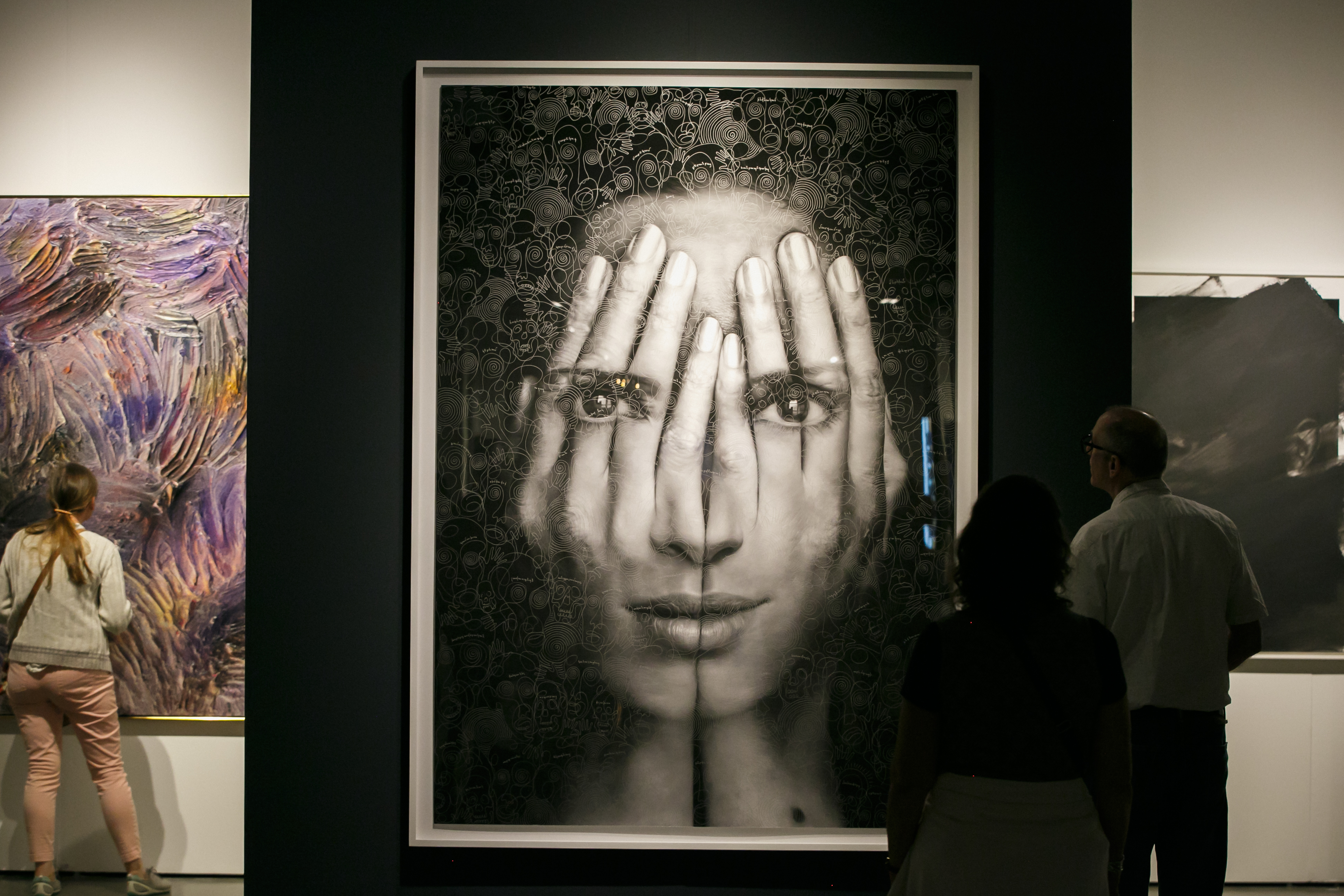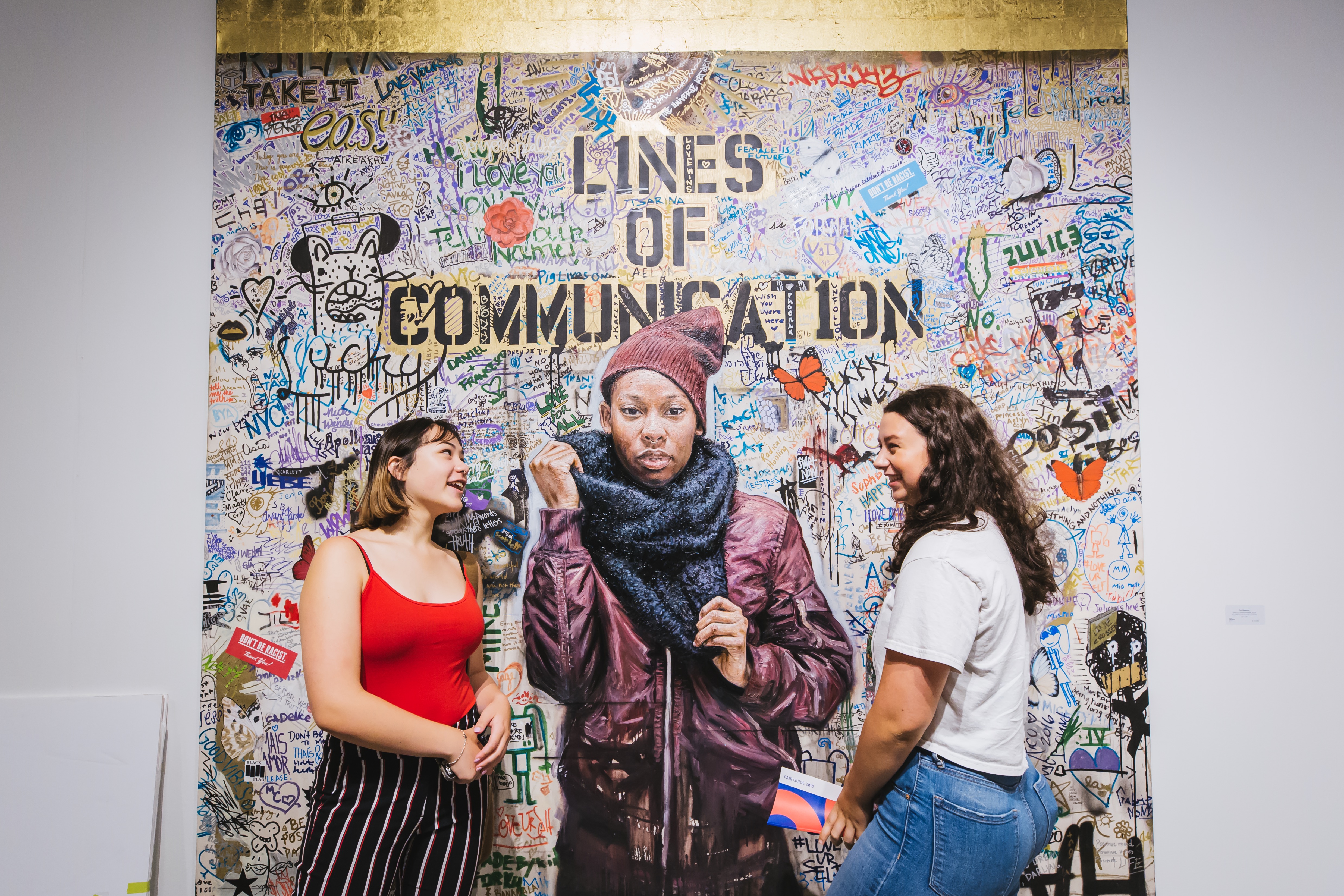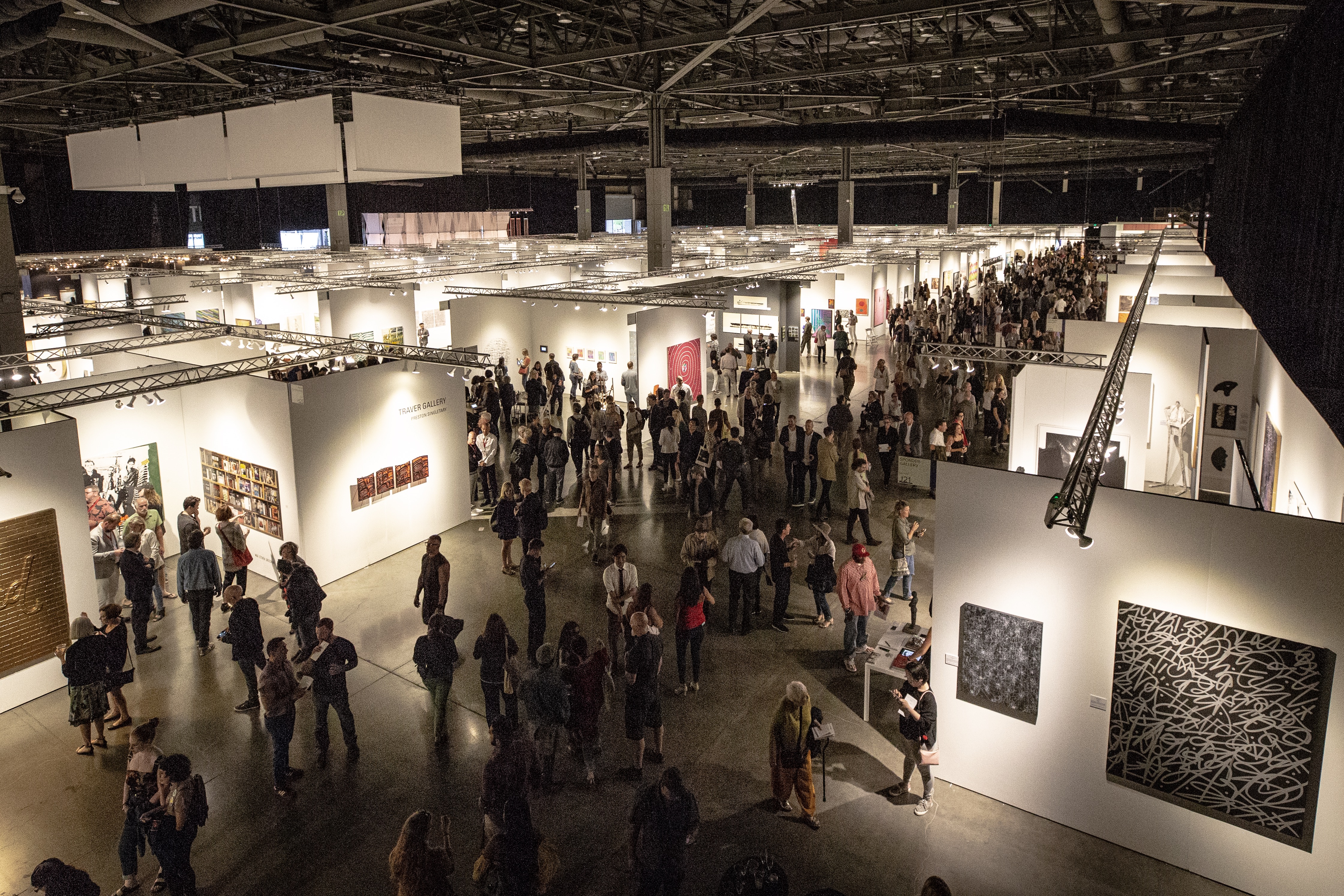Though the exhibitor list has grown to more than 100 galleries, with a continuing steady presence of Seattle art dealers and out-of-town galleries, plus an increasing number of international outfits, the presence of so-called “blue-chip” New York galleries has peeled off in the past couple of years. Zwirner, Gagosian, Pace, Paul Kasmin and Lelong & Co. all have stopped coming back.
A couple of prominent Pacific Northwest galleries, including Adams and Ollman from Portland, as well as Abmeyer + Wood, Foster/White and G. Gibson from Seattle, are not returning either.
There are different reasons for the latter: Some galleries are closing their brick-and-mortar space, others are moving or have moved to other cities, some can’t attend for personal reasons or had to choose between different fairs. The rationale for this year’s blue-chip absenteeism is unclear. (Gagosian and Zwirner did not respond to requests for comment.)
Greg Kucera, Seattle’s leading art dealer of the eponymous gallery, offered up an explanation: “What happened between last year and this year?” he said. “That’s the question. And I suspect the answer is Paul Allen died, and they [blue-chip galleries] didn’t feel that connection or obligation to this art fair.”
The absence of the Microsoft co-founder, philanthropist and founder of the Seattle Art Fair, who died last October, will loom large this year. Allen’s pull on the fair was great, both as its ambassador and as one of the region’s and world’s most important art collectors and philanthropists.
“I think Paul did buy significantly at the fair,” said Kucera. “And it kept people coming back. But with him gone, people don’t know whether the rest of the Allen organization is going to continue to buy art at the same rate.”
“On the upside,” said Kucera, it also means more chances for local dealers to rise to the top. “Without those galleries, a different hierarchical order appears.”
While the shifting exhibitor list signals an art market in flux and reconsidering the omnipotence and viability of the art fair, it also shows how a young fair grapples with its identity as it comes of age without its progenitor.
The Seattle Art Fair was Paul Allen’s brainchild. The idea came to him after visiting the Venice Biennale, arguably the world’s most prestigious international art exhibition, and Art Basel, the world's biggest art fair, both glitzy global art world and market vortexes.
He wanted something similar to boost the art market and arts in his hometown. So he enlisted his billion-dollar private company, Vulcan Inc., and the New York-based art fair producer Art Market Productions to birth the Seattle Art Fair. With roughly 60 galleries attending, the fair kicked off modestly. That a handful of big-time galleries signed on was a remarkable stamp of approval.
Without the marquee names, the fair loses some of these galleries’ “magnetic effect” on lesser-known galleries, said Tim Schneider, art market expert and reporter at artnet News. “I would personally be concerned about the absence of those galleries this year. When the largest, top-tier galleries pull out, they don’t usually tend to come back.”
Schneider says it could go both ways. Either there’s a cascading effect and the next tier of galleries starts to leave as well, causing the fair to sizzle out. Or, he said, it’ll continue as a so-called “regional” art fair showcasing galleries with a smaller global footprint and visibility — and ditto for the price tags.
For now, this year’s exhibitors’ list points in the latter direction.
Max Fishko, Seattle Art Fair director, acknowledged the fair’s lineup has shifted. “Fairs develop as the market does. I think that the exhibitor list this year is reflecting what the marketplace is looking for right now,” he said, suggesting the recalibration better fits the local and attending collectors' preferences. “A lot of things are vying for the attention from lots of these galleries,” he said. “There’s a lot of fairs out there and a lot of opportunities.”
As the art market has globalized and grown into a pressure cooker of extreme global wealth, so have art fairs. The number of art fairs has skyrocketed in the past 10 to 15 years and with it the pressure to participate in them, despite tremendous costs for galleries (in the tens-of-thousands of dollars or more). In response, “fair fatigue” (though perhaps fair indigestion would be a better term) has set in.
Galleries, particularly smaller ones, are rethinking how many fairs they can participate in without losing their shirt.
Sharon Arnold of the now-closed Georgetown gallery Bridge Productions was one of them. Arnold (who uses gender-neutral pronouns) says their gallery has never broken even in its three years at the fair — even when it sold out its booth in 2017. As Arnold was considering a new gallery model, Bridge Productions decided not to return in 2018.
For some smaller galleries, the presence of big shot galleries was part of the draw and calculations, said Arnold: “One of the most unique attributes of SAF is that small galleries like mine could be present right alongside giants like Zwirner, Pace and Gagosian. Most of the time, those guys have their own fancy fairs, and then the rest of us are in some other fair.”

With or without the blue chips, the risk and investment of participating in the fair are worth it to “get your name out there,” said Judith Rinehart, who’s participating in the fair for the first time with her new Seattle gallery J. Rinehart Gallery. “You have to approach it as it is: This is an event about marketing” the gallery artists. “Making money is the result, not the reason,” she said.
But, warned Schneider, even if art dealers make connections, if they don’t make enough sales, they eventually pull out. Given that the majority of revenue for the organizer comes from booth fees and not ticket sales, this could put a fair's revenue at risk, he said.
“That’s the challenge with some of these regional fairs ... with probably fewer collectors,” he said. “It’s easier for those fairs to go under than major fairs.”

Though the Pacific Northwest is seen as a “regional” market, meaning its crop of high-profile collectors and art market is smaller than art world nerve centers like New York or London, the risks for the Seattle Art Fair might be mitigated by the fact that Vulcan owns the venue: CenturyLink Field.
Five years in, it’s hard to gauge whether Allen’s grandiose gift to the city has richly rewarded the arts scene. Local artists say they are not really feeling or seeing the monetary or other ripple effects; though, for some, the fair has resulted in a bump in sales and exposure.
“It was honestly what had kickstarted the opportunities that would soon after come my way,” said local breakout talent Anthony White of his debut at Greg Kucera’s booth last year at the fair. Kucera says collage artist Joe Rudko had his work discovered by Davidson Gallery in New York, which now represents him. Arnold of Bridge Productions landed local painter Emily Gherard in prestigious company by selling a large Gherard painting to Alice Walton, Walmart heiress and founder of the Crystal Bridges Museum of American Art.
But not everyone has a gallery to bring their work to the fair. So longtime Seattle artist Barbara Earl Thomas had to venture out of her comfort zone. In 2016, armed with a stack of printed portfolios, she introduced herself to gallerists at the fair, every day, until closing time. “My feet were so tired,” she said. “I could barely make it across the parking lot.” On the last day of the fair, she dropped her last packet off with Claire Oliver the eponymous New York gallery.
“I said: You will not throw it away until I’m gone. And I went home.” A couple of weeks later, she got a call from Oliver. Thomas since had a solo show at the gallery and has shown her work at fairs in Miami and Chicago.
And with that, Thomas said, “the Seattle Art Fair has changed my life.”
Though many say the fair has cracked open some of Seattle’s insularity by exposing it to more art from more countries while injecting new curator and collector blood into its veins, most local artists’ lives and careers have stayed largely untouched besides enjoying a four-day art bender.
Shaun Kardinal, local artist, curator and art collector who will show his work at the fair for the first time this year, compared the shifting mood of the city’s art scene during the fair with a so-called Seattle Speedball: an (un)holy alliance of the city’s favorite ingestible things: coffee and marijuana. “Your mind is pinging from all these aesthetics and visuals; it’s kind of overwhelming; it amps you up in a way,” he said.
But like a speedball, the effects are fleeting — a small bump in sales or exposure, if you’re lucky, excitement for everyone else. “I’ve not heard or seen anybody really having a ripple effect over time,” Kardinal says.
“I see it as an enjoyable event that I can goof off at, and then it leaves town, and we’re back to struggling to pay rent and find places to work,” said Clyde Petersen, a filmmaker and artist with a show at Pioneer Square gallery Party Hat opening on Thursday. “It is getting harder and harder to be an artist, regardless of the art fair, because of lack of housing and studio space.”
Even though the fair has spawned local excitement as well as other local art fairs and exhibitions, such as Out of Sight (which was halted after three years when the organizers couldn’t find real estate to house it), 1Room and exhibitions at King Street Station, some artists and culture workers feel a certain ambivalence toward the fair.
Some of this rises from a feeling the fair was never meant for them in the first place.
“If you wanted to help the city, where was the community forum to ask artists what they wanted and needed?” said Satpreet Kahlon, artist and member of the curatorial team of the yearlong indigenous-led arts project yәhaw̓.
And while the public programming is great, couldn’t the fair do more to lure collectors and visitors out to galleries and art spaces across the city, Arnold asked. Couldn't it, like Prospect New Orleans, a contemporary art triennial, include local citywide events into its official calendar to extend visibility?
Allen and Vulcan’s role in the fair might have been a boon and sign of credibility to some. For others, it also has been a liability.
Local artist Kardinal noted that past experience taught local artists and musicians that Allen’s generosity depended largely on his whims. “There’s always a feeling that it’s temporary at best,” he said. “We don’t know how long it’s going to be here.”
For now, the Seattle Art Fair won’t go the same route as short-lived Allen projects such as the Upstream Music Festival, which ended after a two-year run earlier this year, and South Lake Union exhibition space Pivot Art + Culture, which ended with its opening exhibition. Art Market Productions confirmed that the Seattle Art Fair would take place again next year, again co-produced with Vulcan Arts + Entertainment.
But for some, a few financial or other rewards don’t balance out the role the development arm of Vulcan, and Allen by extension, has played in gentrification and displacement in the city.
“If the same person who funded the art fair is the same person who has made it really impossible for so many of us to live here, what does that mean?” asked Kahlon. “Making one sale every year — if it happens — does that make up for a lifetime of instability in the city?”






